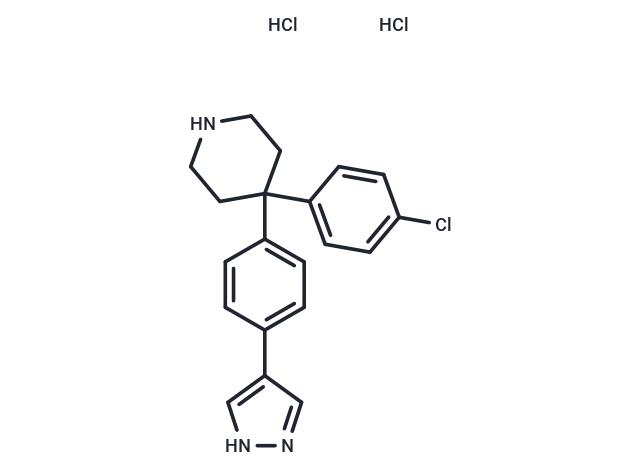Shopping Cart
Remove All Your shopping cart is currently empty
Your shopping cart is currently empty
AT7867 dihydrochloride is a potent ATP-competitive inhibitor of Akt1/Akt2/Akt3 and p70S6K/PKA kinase, with IC50 values of 32 nM/17 nM/47 nM and 85 nM/20 nM, respectively. It induces pharmacodynamic changes and inhibits human tumor xenograft growth.

| Pack Size | Price | USA Warehouse | Global Warehouse | Quantity |
|---|---|---|---|---|
| 2 mg | $53 | 5 days | 5 days |
| Description | AT7867 dihydrochloride is a potent ATP-competitive inhibitor of Akt1/Akt2/Akt3 and p70S6K/PKA kinase, with IC50 values of 32 nM/17 nM/47 nM and 85 nM/20 nM, respectively. It induces pharmacodynamic changes and inhibits human tumor xenograft growth. |
| Targets&IC50 | Akt3:47 nM, PKA:20 nM, Akt2:17 nM, Akt1:32 nM, p70 S6K:85 nM |
| In vitro | AT7867 ATP-competitive inhibited AKT2 with the Ki of 18nM. AT7867 also shows potent activity against the structurally related AGC kinases p70S6K and PKA, but shows a clear window of selectivity against kinases from other kinase sub-families. In vitro growth inhibition studies show that AT7867 blocks proliferation in a number of human cancer cell lines. AT7867 appears to be most potent at inhibiting proliferation in MES-SA uterine, MDA-MB-468 and MCF-7 breast, and HCT116 and HT29 colon lines (IC 50 values range from 0.9-3 μM), and least effective in the two prostate lines tested (IC 50 values range from 10-12 μM) [1]. |
| In vivo | After oral administration of AT7867 at a dosage of 20 mg/kg, its elimination from plasma mirrors that observed with intravenous (i.v.) administration. Plasma concentrations of AT7867 exceed 0.5 μM for a minimum of 6 hours post-oral dosing at 20 mg/kg. Based on the assumption of linear pharmacokinetics from i.v. administration, the oral bioavailability of AT7867 is estimated at 44%. Consequently, in vivo pharmacodynamic (PD) biomarker studies utilize this model. Subsequent to pharmacokinetic and tolerability assessments, AT7867 doses (90 mg/kg orally or 20 mg/kg intraperitoneally) are given to athymic mice harboring MES-SA tumors, with a focus on monitoring the phosphorylation levels of GSK3β and S6RP within the tumors over time. A significant reduction in the phosphorylation of these two pathway markers is observed at both 2 and 6 hours post-AT7867 administration. By the 24-hour mark, the total levels of GSK3β and S6RP have substantially decreased [1]. |
| Molecular Weight | 410.77 |
| Formula | C20H22Cl3N3 |
| Cas No. | 1431697-86-7 |
| Relative Density. | no data available |
| Storage | Powder: -20°C for 3 years | In solvent: -80°C for 1 year | Shipping with blue ice/Shipping at ambient temperature. |
| Size | Quantity | Unit Price | Amount | Operation |
|---|

Copyright © 2015-2025 TargetMol Chemicals Inc. All Rights Reserved.